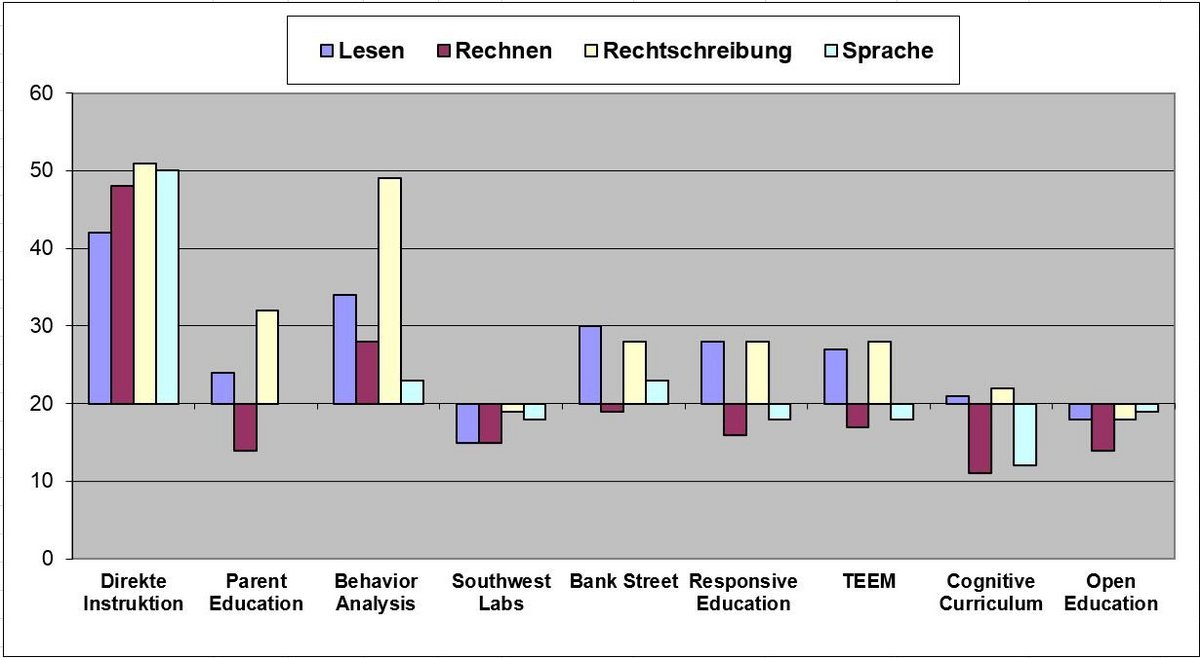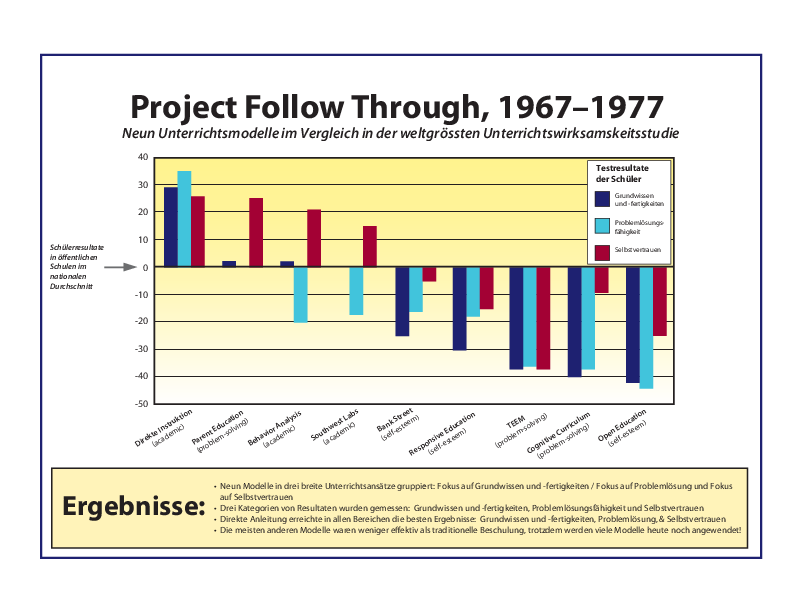Direct instruction wins world’s largest tuition effectiveness study
by Peter Aebersold
America’s longest, most important and most expensive study on the effectiveness of tuition methods in state schools had a clear winner: the joint classroom instruction in the form of “direct instruction”.
“Direct instruction” is a teacher-centred teaching method for learning factual and basic knowledge and for developing cognitive skills. The teacher actively controls and structures the learning process. “Direct instruction” emphasises basic skills and breaks them down into small learning steps. For example, children learn to read by learning the pronunciation of the letters ahead of learning the letters’ names. They need to master each skill before moving on to the next. Teachers daily monitor each student’s progress. They pay attention to their behaviour and encourage good behaviour. They largely ignore bad behaviour if they perceive it as the expression of a discouraged student. They assume that bad behaviour will resolve itself once the student experiences success in learning.
Discerning homophone words
The children are classified primarily according to their performance level and not according to their age or other criteria. They benefit most if they form a class that is as homogeneous as possible, in which everyone is able to follow the lessons. That is why classroom teaching moves forward only if everyone has understood the material.
The long-term study “Project Follow Through” (FT) began in 1968 and ended in 1995 after almost 30 years, and with over 100,000 participating students in 180 school communities and costs of around one billion dollars, it is still the world’s largest educational and scientific experiment. The goal was to find the most effective methods of teaching underprivileged children. Disadvantaged students, who had previously only achieved the 20th percentile (corresponding to a grade of 1.2 on a grading scale with 6 as the highest grade), should be brought from this starting level to the average American level (50th percentile, corresponding to grade 3).
The US Department of Education (DOE) financed 22 very different educational programmes in 51 school districts with a disproportionate number of poor children. Standardised test results were collected from nearly 10,000 Follow Through children and from children who did not participate in the Follow Through programme. The DOE-approved models were developed by educational scientists from renowned American universities. The only exception was the “direct instruction” model developed by preschool teacher Siegfried Engelmann from Illinois. The educational scientists drew on the pedagogical theories of John Dewey and Jean Piaget, while Engelmann developed his model in cooperation with fellow teachers and based on experiences from everyday school life.
The evaluation of the follow-through data took nine years. The evaluation cost 30 million dollars and was performed by two independent institutes. The results speak for themselves: In terms of school performance, the children who participated in the “direct instruction” method outperformed their peers in the scientific comparison groups. “Direct instruction” was the only method that achieved the goal of bringing the performance of weaker students very close to the American average in all subjects (reading, arithmetic, spelling, language as well as basic skills, cognitive abilities and self-esteem). Later evaluations of 1,000 graduates of the “direct instruction” programme showed its sustainability. They were still ahead of their comparative cohorts in the senior high school graduating class (12th grade, 17-year-olds).
Despite this great success, the US federal oversight panel for “Follow Through” ended the “direct instructions” programme and cut its budget, while continuing other methods that led to spectacular flops. School politicians never accepted the “Direct Instruction” because they were not satisfied with the results of the scientific evaluation.
Educators who enthusiastically chose one of the “modern” methods of the educational scientists (open forms of teaching, self-directed learning, competence orientation, constructivism, etc.) for their lessons refused to give them up, even though they were not very effective. They tried to teach the children how to learn on their own, thus trying to increase the self-esteem of their students. The result was that the students in these models achieved even lower levels of reading and mathematics than the control groups who were not in the Follow Through programme.
Yet these failed programmes have spread through America “like fire through dry corn”. The “modern” straw fire spread first to the Anglo-Saxon countries and then, encouraged by the OECD, to the OECD countries. Ironically, with PISA, the OECD also provided the measuring instrument to show how school performance is going downhill in the competence-oriented OECD countries.
The “Follow Through” project showed that scientific impact research, which has recently been impressively confirmed by Hattie’s meta-meta study, and “modern” classroom practice were still alien to each other. The United States has thus missed a unique opportunity. Until both pull together, American schoolchildren will continue to receive second-class education.
Inadequate education impoverishes not only the less educated classes, but also entire countries. It is probably no coincidence that the Asian PISA winners, with their proven education system and traditional methods, have succeeded in lifting over 700 million people out of poverty over the last four decades.
For Switzerland, the debacle with the competence-oriented, low-impact “passe-partout” teaching materials should be a clear warning signal. •
Sources:
Tashman, Billy. Our Failure to follow through. New York Newsday of 15 November 1994
Grossen, Bonnie. University of Oregon: The Story Behind Project Follow Through
Engelmann, Siegfried. War Against the Schools’ Academic Child Abuse. Halcyon House, Portland 1992
Adams, Gary L.; Engelmann, Siegfried. Research on Direct Instruction: 25 Years Beyond DISTAR. Educational Achievement System, Seattle WA 1996
Engelmann, Siegfried. Teaching needy kids in our backward system: 42 years of trying. Association for Direct Instruction ADI Press, Eugene (Oregon) 2007.
de.wikipedia.org/wiki/Project_Follow_Through
de.wikipedia.org/wiki/Siegfried_Engelmann
(Translation Current Concerns)

The researches lesson models were divided in three largely defined groups:
- The “affective skills models” (including “self-esteem”) focussing on the promotion of a positive self-esteem so that learning and development of pupils with socially-challenged backgrounds could be stimulate. Experience, which strengthens self-esteem, were according to the assumption, a catalyst for learning at all levels (“Bank Street”, “Responsive Education” and Open Education”.
- A further category (labelled “problem solving” or “cognitive skills models”) concentrated on the encouragement of thinking and problem-solving capabilities. The overwhelmingly complicated problem should automatically lead to the acquisition of basic skills and self-esteem (“Parent Education”, TEEM”, “Cognitive Curriculum”).
- The category “basic skills models” or “academic” depends on the fact that learning must occur from the bottom to the top. Which means that the children who build upon the learning and mastering of basic speech and mathematics skills, are able to develop complicated thinking and problem-solving capabilities as well as self-esteem (“Direct Instruction”, “Behaviour Analysis” and “Southwest Labs”).
- Results which lie above the 0-axis show a positive change in each area. Those which lie below the 0-axis show a deterioration in the respective areas.
